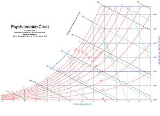What is the practical difference between wet bulb temperature and adiabatic saturation temperature?
How a process engineer differentiate these terms while working in the field i.e; on cooling towers?
replied to: hamzashah
Replied to: What is the practical difference between wet bulb temperature and adiabatic...
If you mark your current state on a psychrometric chart, then the wet bulb temperature is obviously the wet bulb temperature at that point. If you draw the constant enthalpy line through the point, the wet bulb temperature (or the dry bulb temperature) at the point where the constant enthalpy line intersects the 100% relative humidity curve is the adiabatic saturation temperature. The wet bulb and dry bulb temperatures are the same on the 100% RH curve. There will not be much difference between the wet bulb temperature and the adiabatic saturation temperature, but this difference is affected by the atmospheric pressure
Psychrogen 2.0, available from www.psychrogen.co.uk is a unique aid to learning and using psychrometry. It is an especially useful tool to explore the relationship between the various psychrometric properties over a wide range of pressures and altitudes. PsychroGen 2.0 has the unique ability to plot psychrometric properties against any pair of parameters on the X & Y axes and questions of the type that you have asked can be very easily be investigated using PsychroGen 2.0
replied to: ZacVeetil
Replied to: If you mark your current state on a psychrometric chart, then...
ZacVeetil's definition of the adiabatic saturation temperature is not correct as can be seen by the equation which defines the adiabatic saturation temperature.
The following site is one of many displaying the equation (which in this case is for temperatures above freezing).
Scroll to the last equation
http://www.ageng.ndsu.nodak.edu/envr/PsycEqns.htm
hs* = h + hw*(Ws* - W)
The asterisk indicates that the associated property is at the thermodynamic wet bulb temperature also known as adiabaatic saturation temperature.
hs* is greater than h by the quantity: hw*(Ws* - W).
A simplified statement is that the entering enthalpy (in the adiabatic saturation process) is increased by the mass of water added in the process times the enthalpy of the added water.
replied to: hamzashah
Replied to: What is the practical difference between wet bulb temperature and adiabatic...
The following questions appear on http://www.absoluteastronomy.com/discussion/Psychrometrics
“What is the practical difference between “psychrometer” wet bulb temperature and adiabatic saturation temperature?” and “How (can) a process engineer differentiate these terms while working in the field i.e; on cooling towers?”
Quick Answer
There is no significant difference at earth’s surface temperatures and pressures provided that the “psychrometer”-wet-bulb temperature as obtained using a sling or Assman psychrometer is made following ALL instructions on the use of the instruments.
THE WETBULB TEMPERATURE ISOLINE ON VIRTUALLY ALL PSYCHROMETRIC CHARTS REPRESENTS THE THERMODYNAMIC WETBULB TEMPERATURE; A.K.A. THE ADIABATIC SATURATION TEMPERATURE. A possible exception is that some CIBSE (see footnote) charts utilize psychrometer wetbulb temperature apparently using defined values of air velocity, external radiation, view factor, heat transfer coefficient and mass transfer coefficient.
Footnote: (The Chartered Institution of Building Services Engineers with 16 regions in the UK and 3 overseas)
There are thousands of pages of technical papers that address the theory of the wetbulb psychrometer. The adiabatic saturation temperature is elegantly described by h_1 + (WSAT_2 – W_1) ● hCOND_2 = hSAT_2
Additional Information from “Understanding Psychrometrics”, 2nd Edition, ASHRAE, 2005, ISBN 1-931862-83-4, Wet-bulb Temperature Chapter, pages 111-115
“It is fortuitous for the mixture of dry air and water vapour that “psychrometer” and “thermodynamic” wet-bulb temperatures are for practical purposes equal provided that the psychrometer is correctly used.” (Anonymous quotation)
In psychrometrics, there are two wet-bulb temperatures: (1) thermodynamic wet-bulb temperature (also called the temperature of adiabatic saturation) and (2) psychrometer wet-bulb temperature.
For any given moist air state, THERMODYNAMIC WET-BULB TEMPERATURE has a fixed mathematical value based on thermodynamic properties. Thermodynamic wet-bulb temperature is calculated using mass and energy balance equations of an adiabatic saturator. Realistically, the adiabatic saturator is a theoretical instrument because it must be perfectly insulated, be very long, and have intimate contact between the air and water.
PSYCHROMETER WET-BULB TEMPERATURE for the mixture of dry air and water vapour is the temperature measured by an ordinary thermometer that has its sensing element covered with a clean, soft cotton sleeve wetted with distilled water and exposed to moist air moving at 4 m/s ± 1 m/s. The thermometer bulb should be shielded from direct solar radiation but exposed to normal background radiation.
Psychrometer wet-bulb temperature is not a true thermodynamic property because it is dependent on heat and mass transfer rates, which are functions of (a) air velocity, (b1) external radiation and (b2) view factor, (c) water temperature as it arrives at the bulb-wick interface, (d) diffusivity of the sock, (e) convection coefficient, and (f) heat conduction up the thermometer stem.
The psychrometer wet-bulb thermometer’s combination heat and mass transfer process is not the same as the adiabatic saturation process; however, …(continued in next paragraph but separated for emphasis)
(continuing) … for air and H2O substances, the deviation between the two wetbulb temperatures is not significant WHEN THE PSYCHROMETER IS CORRECTLY USED. This is not true for other volatile compounds in contact with other mixtures of dry gases and the vapour phase of the volatile compound.


